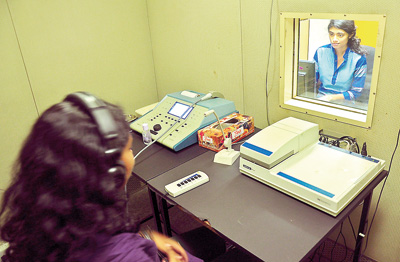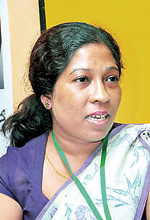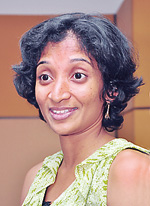Start young to ‘hear’ the results
View(s):
Tests being conducted at the centre. Pix by Mangala Weerasekera
Tucked away down a narrow street, the Ratmalana Audiology Centre attracts patients from not just Colombo but Galle and Kalutara as well. They come in all shapes and sizes, but many are much younger than you would expect. It’s because the team here believes in the benefits of early diagnosis. They are able to test and then design interventions for children who are no more than a few months old. Some of their patients are so young that they haven’t even begun to speak yet but the connections between hearing and the development of speech are strong – if a child is unable to hear well, this often translates into delayed speech and development, the effects of which are felt for the rest of their lives.
Science offers its own reasons for why some children experience this particular challenge. A poster in the centre’s waiting room elaborates: babies who do not cry immediately after birth or are on ventilator support for a long time are said to be more at risk of hearing loss. Other known risks include a family history of deafness, jaundice, infections the mother passes to her baby in the womb (such as toxoplasmosis, measles, or herpes), infections that can damage the brain after birth (such as meningitis or measles) or a birth weight of less than 1500 grams.
Hearing loss is sometimes tied to problems with the outer or middle ear. These can slow down or interfere with sound waves passing through and have causes as varied as birth defects that have led to damages in the ear canal or a build-up of scars on the eardrums from multiple infections. A problem with the inner ear may also lead to hearing loss, this time because of damage to nerve endings through things like exposure to certain toxic chemicals or medicines while in the womb or after birth, as well as tumours and genetic disorders among others.

Asha Perera
Renuka Fonseka, the centre’s audiologist lists some signs parents would do well to take heed of: new-borns that don’t get startled when they hear a loud noise nearby may have hearing problems. Young children also tend to be fond of noisy toys, and indifference to these could be a warning sign. Older infants, who should respond to familiar voices may show no reaction when spoken to. She explains that on average, children are expected to use single words by a year and simple two-word phrases by age two – delays may indicate hearing loss.

Renuka Fonseka
Subhashini Sukumar is the centre’s speech language pathologist and also serves as an audiologist. She often sets the assessment tests for new patients and says that care must be taken to eliminate other possible causes of delayed speech such as autism. If the problem is truly hearing loss, the centre’s team must decide what the best intervention will be. In many cases this takes the form of a hearing aid. In more serious cases, surgery may be called for. However, hearing loss, such as those caused by infections might in some cases be reversible with the right treatment. While the centre offers diagnosis as well as some therapy, they will also direct patients to the doctors where appropriate.
Children with hearing loss are typically diagnosed at 2 – 3 years of age, when the problem becomes impossible to ignore, but Subhashini sees real advantages in beginning treatment much earlier. In fact, where necessary it’s ideal if the hearing aid can be fitted by six months. Even very young children can be taught to use a form of communication based on pictures, while older children could benefit from learning sign language and lip reading skills. Taken together, such strategies can help ease the frustrations of being unable to communicate through normal means.
Funded by Dialog Telecom as part of a CSR initiative, the Ratmalana Audiology Centre offers the students of the nearby School for the Deaf (run by the Ceylon School for the Deaf and Blind) free treatment. The centre takes on paying customers from outside – not just children but adults too.
One of the few centres designed explicitly to serve this purpose, the building houses rooms for testing and treatment, as well a play area for youngsters. They offer some of the essential tests such as Otoacoustic Emissions test(OAE) Brain Stem Evoked Response Audiometry test (BERA), Auditory Steady State Response (ASSR), Behavioral Observation Audiometry test (BOA) as well as intermittence audiometry and free field audiometry. As you’d expected for something designed to be administered to very young children, the tests are pain-free and simple to administer. If a hearing loss is detected the centre is also able to provide a hearing aid as well to look after its maintenance.
However, for patients some key problems remain. Finances in particular can prove a heavy burden with hearing aids routinely costing over Rs.50,000 apiece and more cutting edge technologies costing in the millions. In some cases regular visits are called for, such as for those who wish to consult Asha Perera, the centre’s special education therapist. She explains that after identifying the issues she can design appropriate interventions. Subhashini explains that even more than the team, the parents make the most difference. For instance, once the hearing aid has been fitted, it is the parents and others around the child who must spend time simply talking and engaging with the child to enable proper development of the speech and language centres in the brain.
There is a need to have teachers better informed and able to work with students with learning disabilities . The good news is that only one in a 1,000 children experience profound hearing loss which may prove impossible to treat. For most others treatment options exist that can help them and with therapy allow them to follow a normal arc of development. As with so many conditions when it comes to treatment of hearing loss, the earlier one begins the better.


